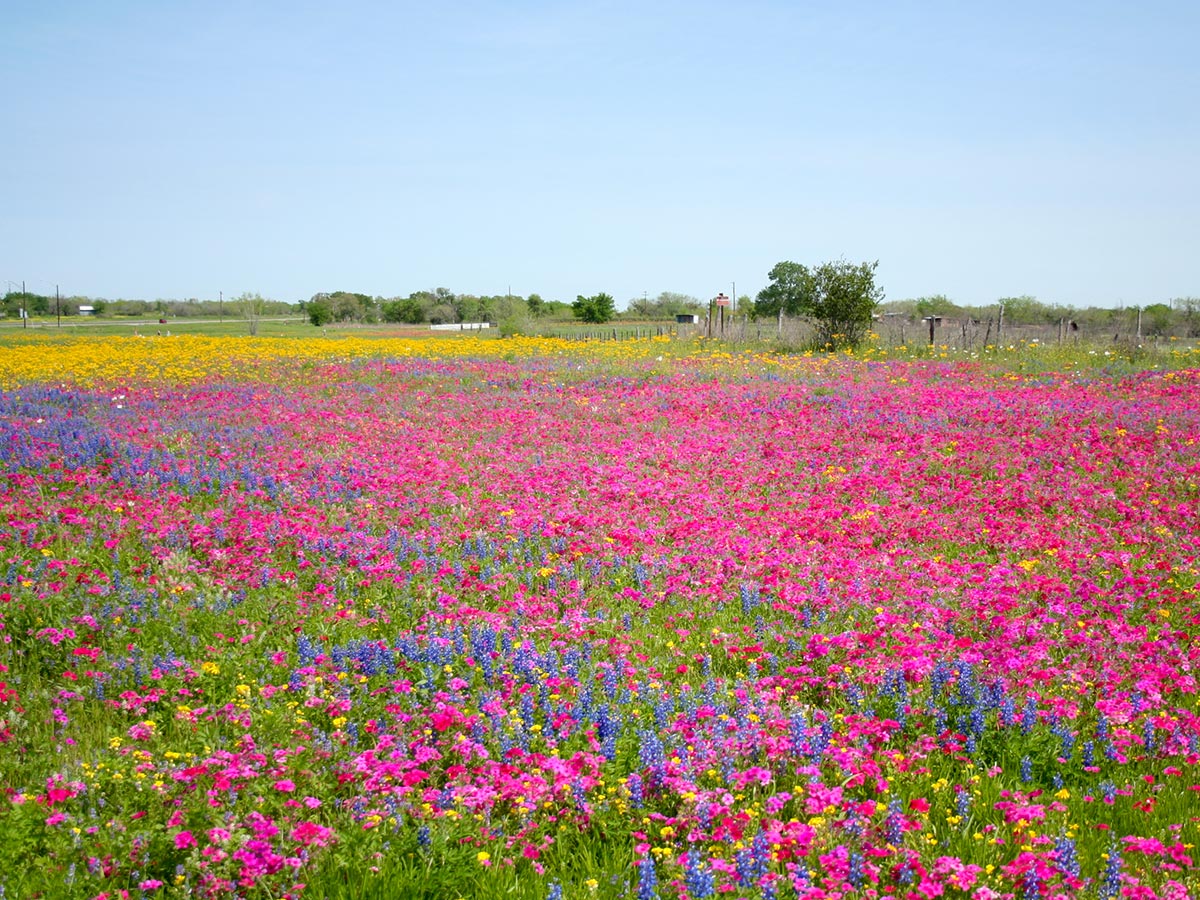PRESSROOM
2018 Wildflower Season Expected To Be Typical, But Still Terrific

A wildflower display featuring bluebonnets and Drummond’s phlox outside of Seguin, Texas from April 3, 2010. PHOTO Courtney Lykins
AUSTIN, Texas – The spring wildflower season is on track to be typical in many parts of Texas, say experts at The University of Texas at Austin’s Lady Bird Johnson Wildflower Center. But an average wildflower season in Texas is still well worth a road trip.
Avid wildflower watchers may remember that last year’s unusually warm and wet winter made for an early wildflower season frenzy. This year, by comparison, is expected to be perfectly average. With a slightly drier fall and winter, and cold snaps throughout the winter, wildflowers are taking the usual time to send forth their flower buds and unfurl their petals. The warmer days last week and recent rainfall should help signal the plants to proceed as expected.
“We’re already seeing bluebonnets and a few other wildflowers pop up in small numbers along roadsides, particularly near the warmer urban core of Central Austin,” says Andrea DeLong-Amaya, director of horticulture at the Wildflower Center. “Overall, wildflowers and other spring bloomers seem right on track. We expect beautiful displays to unfold over the next month or two as is typical.”
It’s not surprising that blooms get going faster in regions where temperatures are higher earlier in the year, and botanists in South Texas say that recent rainfall may be even more of a bloom booster. In Starr County (on the U.S./Mexico border between McAllen and Laredo), many native yellow wildflowers are already in bloom, including bladder pod (Lesquerella spp.), bahia (Bahia absinthifolia), bitterweed (Tetraneuris scaposa) and cow pen daisy (Verbesina encelioides). Experts in the area say prickly poppy (Argemone spp.), blue curls (Phacelia congesta), winecup (Callirhoe spp.), phlox (Phlox spp.) and firewheel (Gaillardia pulchella) are all in bloom along FM 755 from Rio Grande City.
Experts at Padre Island National Seashore say that the visitor center is abloom with scarlet pea (Indigofera miniata), southern blanketflower (Gaillardia pulchella var. australis), beach evening primrose (Oenothera drummondii), partridge pea (Chamaecrista fasciculata) and beach ground cherry (Physalis cinerascens var. spathulifolia).
At the Katy Prairie Conservancy west of Houston, experts predict a good wildflower season based on the past year’s weather patterns. The rainfall paired with a couple of hard freezes likely helped to break down seed coats and allow for good germination, though extreme weather events have definitely shaken things up and make the spring season less predictable. Experts at Mercer Botanical Gardens just north of Houston in Humble report that they are still recovering from Hurricane Harvey and that plants have also sustained freeze damage.
With recent rains, experts near Dallas and Fort Worth say that a good wildflower show is right around the bend, so long as no late freezes challenge existing buds. Anemone (Anemone spp.), redbud trees (Cercis spp.) and Mexican plum (Prunus mexicana) are in full bloom. Elbow bush (Forestiera pubescens), a shrub with small but charismatic pompom blooms, has just about finished blooming near Austin but is going strong in the DFW area.
In West Texas, experts say Big Bend bluebonnets (Lupinus havardii) were blooming as early as February. The blooms in the Texas Panhandle will arrive later than the rest of the state as they usually do, with experts reporting few rosettes (small plants) showing after a long, cold winter.
At the Wildflower Center and throughout Austin, Texas bluebonnets (Lupinus texensis) look healthy and plentiful, and though many have not yet bloomed, Wildflower Center experts note that they are primed and ready to go. Bluebonnet displays generally peak around the first week of April, and while it’s not an exact science, blooms have started showing around the Center and the city, with waves of blue sure to follow later this month.
Iconic roadside and park-populating wildflowers such as Indian paintbrush (Castilleja indivisa), firewheel, pink evening primrose (Oenothera speciosa), prairie verbena (Glandularia bipinnatifida) and more are all expected to color the landscape in short order. Center experts say to keep an eye out for large populations of pink evening primrose this year, as they tend to thrive in slightly drier conditions.
Signs of spring are brightening the landscape at the Wildflower Center, home to hundreds of species of native wildflowers. The Center’s arboretum and numerous trails are dotted with early bloomers such as goldeneye phlox (Phlox roemeriana), windflower (Anemone berlandieri) and golden groundsel (Packera obovata).
People looking skyward will be greeted by showy redbud trees (Cercis canadensis), big white bouquets on Mexican plum trees, and the fanned “finger” flowers of climbing coral honeysuckle vines (Lonicera sempervirens). Throughout many neighborhoods, giant spiderwort (Tradescantia gigantea) in hues of violet and blue and notoriously fragrant mountain laurel (Sophora secundiflora) are already in action.
For facts about Texas’ most iconic wildflowers, updates about what’s blooming, recommended drives across the state, and more information about wildflowers, explore the Wildflower Center’s new Texas Wildflower Central website at wildflower.org/texas.
Contributing Experts: Andrea DeLong-Amaya, Ryan Middleton, Neil and Nan Adams, Olivia Sievers Ross, Suzanne Chapman, Toni and Benito Treviño, Sam Kieschnick
